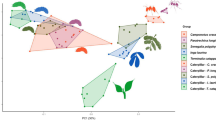Abstract
The effect of temperature on the developmental duration ofCryptolaemus montrouzieri Mulsant was quantified by deriving a regression equation for each developmental stage as well as the total life cycle. While the duration of life stages was shorter during summer and longer during winter, the optimum constant temperature for maximal development was found to be 30°C.
The adult longevity was extended when reared at 20°C than at 30°C and ambient temperature. The longevity of adults was longer when maintained on grape mealybugMaconellicoccus hirsutus (Green) than on honey and when maintained at 20°C. The fecundity of the predator was higher at 30°C than at 20°C. Eventhough the adults could survive at 10°C, the productive capacity was impaired.
Résumé
Les effets de la température sur la durée de développement deCryptolaemus montrouzieri Mulsant, ont été quantifiés en dérivant l'équation de régression de chaque stade ainsi que celle du cycle biologique complet. Tandis que la durée des stades était plus courte durant l'été et plus longue durant l'hiver, la température constante optimale pour le développement maximal était de 30°C.
La longévité de l'adulte augmentait quand il était élevé à 20°C plutôt qu'à 30°C ou qu'à la température ambiante. La longévité des adultes s'accroissait lorsqu'ils étaient maintenus surMaconellicoccus hirsutus (Green) plutôt que sur miel ainsi qu'à 20°C. Mais la fécondité du prédateur était plus grande à 30°C qu'à 20°C. Bien que les adultes puissent survivre à 10°C leur capacité de reproduction était diminuée.
Similar content being viewed by others
References
Bodenheimer, F. S. — 1951. Citrus Entomology in the Middle East with special reference to Egypt, Iran, Palestine, Syria, Turkey. —Dr. W. Junks, S. — Gravenhage, 663.
Bourne, A. I. — 1936. Department of Entomology. —Bull. Mass. Agric. Exp.Stn., 327, 39–54.
Chacko, M. K., Bhatt, P., Rao, L. V., Anand Deepak Singh, M. B., Ramnarayana, E. P. &Sreedharan, K. — 1978. The use of the lady bird beetle,Cryptolaemus montrouzieri Muls. for the control of coffee mealybug. —J. Coffee. Res., 8, 14–19.
Charansri, V. &Nishida, T. — 1975. Relative abundance of three coccinellid predators of the green scale,Coccus viridis (Green), on Plumeria trees. —Proc. Hawaii. Entomol. Soc., 22, 22–23.
Mineo, G. — 1967.Cryptolaemus montrouzieri, observations on morphology and bionomics. —Bol. Inst. Entomol. Agric. Oss. Fitopat. Palermo., 6, 99–143.
Murthy, M.S. — 1982. Studies on the biology and habits ofCryptolaemus montrouzieri Mulsant[Cocinellidae: Coleoptera]. — M.Sc.(Ag.) Thesis submitted to A.P. Agric. Univ. Rajendranagar, Hyderabad, India (Unpublished).
Author information
Authors and Affiliations
Rights and permissions
About this article
Cite this article
Babu, T.R., Azam, K.M. Biology ofCryptolaemus montrouzieri Mulsant [Coccinellidae: Coleoptera] in relation with temperature. Entomophaga 32, 381–386 (1987). https://doi.org/10.1007/BF02372447
Received:
Accepted:
Issue Date:
DOI: https://doi.org/10.1007/BF02372447




